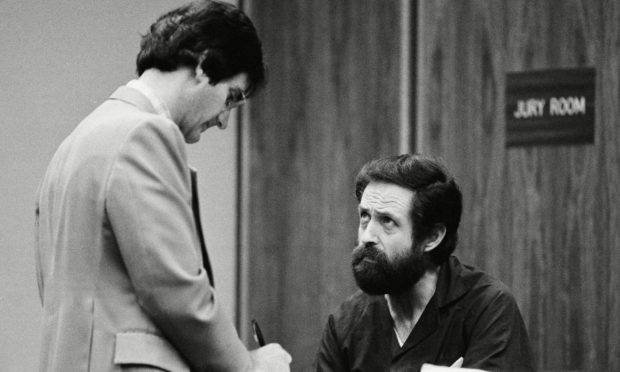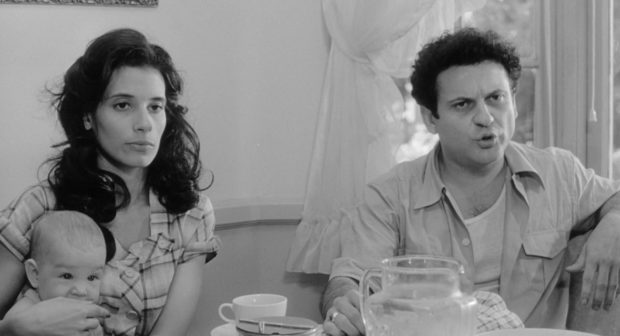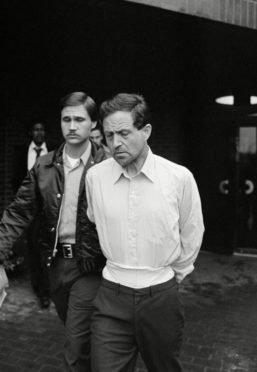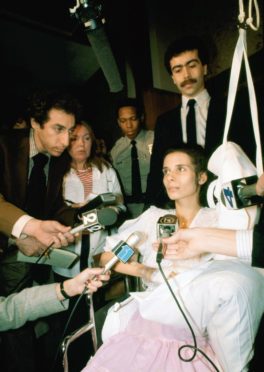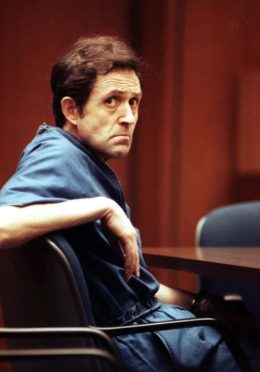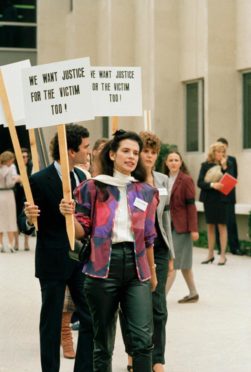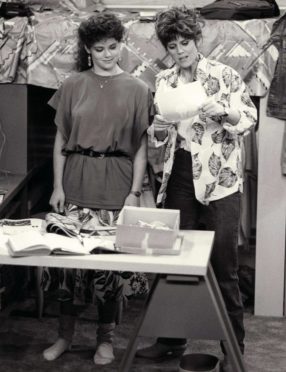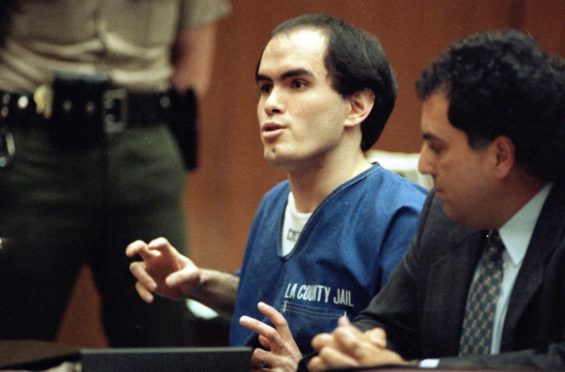Aberdeen man Arthur Jackson was fixated when he first saw Hollywood star Theresa Saldana in the movie Defiance 40 years ago.
Jackson’s movie night at Aberdeen’s Queen’s Cinema on January 26 set in motion a chain of events that would ultimately lead to him travelling to America on a “divine mission” to attempt to kill the actress who played Joe Pesci’s wife in Martin Scorsese’s Oscar-winning film Raging Bull.
As a teenager Jackson displayed strange characteristics which saw him described as a harmless oddball by the few who knew him as he grew up in Aberdeen.
But no one could have imagined the indelible mark he would leave on society.
The film-obsessed amateur scriptwriter claimed Hollywood moguls ripped off his ideas when they made Defiance and cast Saldana in a leading role.
The young actress was now the focus of his schizophrenic delusions and Jackson vowed to track her down to her Hollywood home.
Jackson flew out on New Year’s Day in 1982 after he saved up his airfare to America by not paying rent on his flat in the Seaton area of the city.
Jackson posed as Scorsese’s assistant
Jackson, 46, who had twice previously been deported from the US, got hold of the star’s address after hiring a private investigator to obtain her mother’s phone number.
He called Saldana’s mother and posed as Scorsese’s assistant, saying he needed the actress’s residential address in order to contact her about a film role in Europe.
On March 15 1982 Jackson approached Saldana in front of her West Hollywood home as she was leaving her apartment to go to a music class.
“Are you Theresa Saldana?” he asked.
Saldana attempted to run but Jackson held and stabbed her 10 times with a hunting knife.
Several nerve tendons in one of her hands were severed as she attempted to wrestle the knife from Jackson.
The attack was so fierce that the knife bent.
Most of the blood had drained from her body
Jeffrey Fenn, a water delivery man, heard Saldana’s screams and rushed to her aid.
He pulled Jackson off the bleeding actress and wrestled the weapon from him, allowing her to escape back into her apartment.
She told him: “He killed me.”
The 27-year-old actress was taken to the hospital “virtually moribund”.
While waiting for the police, a witness asked Jackson why he had stabbed Saldana.
Jackson replied that it would all be explained by the contents of his black satchel which lay in the street.
The satchel contained a document entitled “Death Sentence Petition” and a diary inscribed with Jackson’s name which was marked: “Care of the office of Michael, the archangel and vice-president of heaven”.
By the time paramedics got Saldana to Cedars-Sinai Medical Center, most of the blood had drained from her body and her heart had stopped.
Fenn’s heroism, heart-lung surgery and 26 pints of blood saved the life of the actress who spent the next three and a half months in hospital.
Attempts to trace Jackson’s relatives
Jackson denied the charge of attempted murder following a brief Superior Court arraignment in Santa Monica in April 1982 with bail set at $100,000.
Steven Moyer of the Los Angeles county public defender’s office said he was baffled as to why Jackson’s relatives had not come forward to help his case.
Jackson, formerly of School Drive, Linksfield, had earlier given Mr Moyer the names of a number of relatives in the Aberdeen area but attempts to trace them proved fruitless.
Saldana was able to attend Jackson’s trial in a wheelchair in October 1982.
Jackson elected not to enter an insanity plea although the defence consisted solely of the expert testimony of two forensic psychiatrists.
Jackson said he was aware that he had no right to kill Saldana, but “felt that the laws under which he was acting were of a greater force”.
Jackson believed he was acting on behalf of the “Order of the Knights of St Michael” and the “Kingdom of Heaven”.
He believed that he was on a divine “mission” to kill Saldana and take her “with him to the hereafter, the better life, God’s kingdom”.
Jackson had a death wish and intended to be executed by the state “with music over the public address system” and “light refreshment for the observers”.
He begged the judge to give him a gun to kill himself and also pleaded to be locked up at the abandoned Alcatraz prison in San Francisco.
Jackson continued to plot to kill Saldana
The jury rejected the evidence regarding Jackson’s mental state and returned a verdict of attempted murder in the first degree and assault with a deadly weapon.
The court imposed the high base term of nine years for the attempted murder and imposed an additional three-year enhancement on the finding of great bodily injury.
Two years later, after an appeal had reduced his sentence, the judge decided to reimpose the 12-year stretch when Saldana told a court he was still plotting her death.
“Although Arthur Jackson is in custody today, his vicious, calculated plan to kill me is still alive,’ she told the court.
“It is very difficult for me to plan for my future when I have clear written proof of his continuing plan to murder me.”
She quoted from the letter she said Jackson had sent her.
“I swear on the ashes of my dead mother and on the scars of Teresa Saldana, that neither God nor I will rest in peace until the special request in my solemn petition (to kill the actress) has been granted.”
Jackson was due for parole in 1989 but was given a further six years in jail after writing threatening letters to Saldana and her rescuer Jeffrey Fenn.
“The most frightening aspect about them (the threats) is that for the first time since this (attempted murder) happened, he (Jackson) stated he had other people in place to murder me,” testified Saldana.
“I felt my life was in grave danger and the safety of my family was in danger.
“I also watched my family’s reaction (to the letters) and my father’s death within a few weeks of his having seen the letters.”
She said the letters terrified her to the point of causing her insomnia, nightmares, numb feet and hands, and required her to be hospitalised for six weeks.
She said she then had to return to the psychiatric therapy she underwent after the 1982 attack.
Extradited back to England to stand trial
Jackson was held in San Quentin State Prison and the California Medical Facility (CMF) in the city of Vacaville which was home to cult leader Charles Manson.
Jackson was one day away from release on parole when he was extradited to England in June 1996 after he confessed to the killing of a 33-year-old taxi driver.
He gunned down father-of-three Anthony Fletcher at point-blank range in 1967 when he tried to halt Jackson’s escape from a failed bank raid in London.
He was convicted of manslaughter and sent to Broadmoor Hospital before transferring to Carstairs State Hospital where he died in 2004 aged 69.
Saldana went on to found a support and lobbying group, Victims for Victims, and played herself in the 1984 TV movie Victims For Victims: The Theresa Saldana Story.
She also wrote Beyond Survival, a memoir.
Jackson’s attack was the first celebrity stalker case of its type which fundamentally changed how the courts dealt with stalkers thanks to Saldana’s efforts.
Victims for Victims and other organisations joined in a wide-ranging effort to get the laws amended which led to the 1990 passage of America’s first anti-stalking laws.
She died in 2016 at the age of 61.
‘Hollywood star resembled the person who brainwashed me in the 1950s’
Jackson explained why he tried to murder Saldana in a letter to the Evening Express while he was on remand in England in 1996.
He said the obsession that landed him in San Quentin could be traced back to his childhood fixation with films featuring prisoners and dungeons.
Jackson made comparisons between his “siege of trials and tribulations” and those of characters in movies like the Count of Monte Cristo and the Man in the Iron Mask which he watched in Aberdeen in the 1940s.
He also drew parallels between himself and Shakespeare’s Richard III, who he said was the object of misguided public opinion.
His letter, written in small and neat handwriting, claimed a series of events were to blame for him developing a “death wish obsession” for Saldana.
Jackson said he was left damaged by secret brainwashing by the US during the 1950s before he was pushed over the edge when he watched the movie Defiance.
He claimed movie moguls in Hollywood “stole ideas” for the plot which he sent off to film chiefs in 1974 which “led up to the attack on Theresa Saldana”.
“Since the film industry, without my knowledge or consent, selected someone (Theresa Saldana) to co-star in a movie who resembled the person…whom the US Army/CIA experiment unit in Germany had used to work a devastating effect over my mind and emotions,” Jackson said.
“Subsequently when I saw the movie in Aberdeen it triggered a ‘death wish’ obsession for the actress.
“In conclusion, if ever someone has been manipulated and exploited and made a criminal, contrary to his true nature of honesty (the highest standards of integrity), it is surely I.”
Jackson claimed to have enjoyed “life-long virtuous living” having never smoked, drank or gambled.
He said: “Despite the crimes linked to me I am essentially a non-violent peace-loving person.”
Jackson inspired a cold-blooded killing in 1989 which shook the American public
On July 18 1989 sitcom actress Rebecca Schaeffer was at her West Hollywood home preparing to audition for a role in Francis Ford Coppola’s The Godfather Part III.
It would have been the role of her career.
But she never got the chance.
Schaeffer, who was 21, was killed in cold blood in the doorway of her apartment building by Robert John Bardo, an obsessed fan who had been stalking her.
Bardo visited Schaeffer twice on the morning of her death, carrying a loaded .357 magnum pistol in a shopping bag to complete his “mission”.
In the months before he killed Schaeffer, Bardo visited New York’s Dakota apartment building where John Lennon had been shot.
Later, he said, he read a People magazine article about Arthur Jackson and learned that he could hire someone to find out Schaeffer’s address.
Bardo subsequently hired a Tucson private detective, who obtained Schaeffer’s address from the California Department of Motor Vehicles.
In the aftermath, the story of how Bardo got the address and its roots in the Saldana case outraged many.
